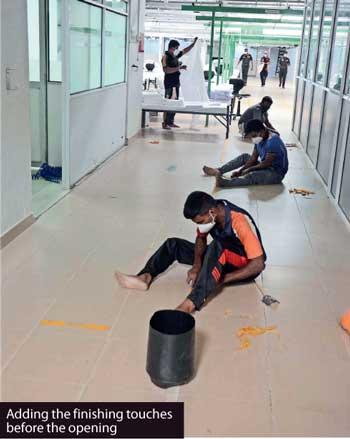Reply To:
Name - Reply Comment
Former apparel manufacturing facility converted to hospital in less than a week
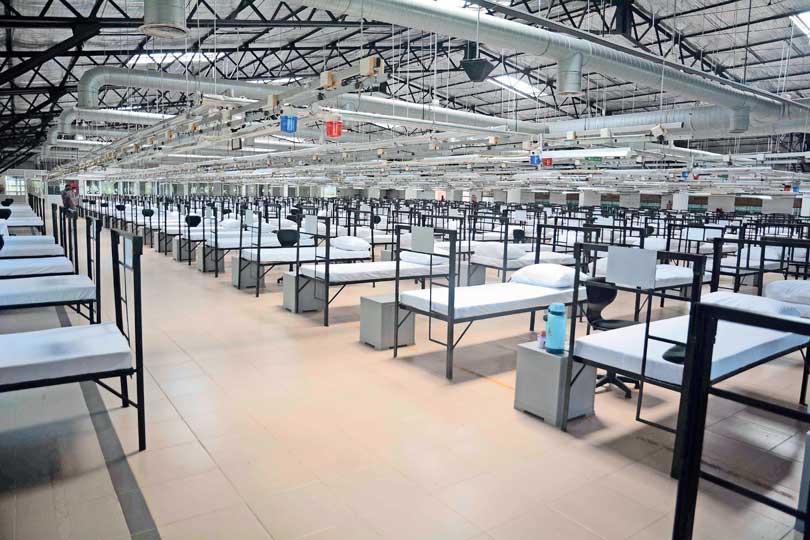
The recently converted facility specialised for Covid-19 patients boasts of 1,200 beds
PIX PRADEEP PATHIRANA
 With mounting Coronavirus cases reported from across the island, the provision of adequate health and medical care for patients has become an immediate national need. With the government’s decision to increase the current bed capacity in the hospital network, the Sri Lanka Army, which has been at the forefront of Sri Lanka’s Covid-19 response, recently improvised a former apparel factory to a fully-functional Covid-19 treatment facility. The hospital opens its doors to the country’s rapidly increasing Covid-19 patients today.
With mounting Coronavirus cases reported from across the island, the provision of adequate health and medical care for patients has become an immediate national need. With the government’s decision to increase the current bed capacity in the hospital network, the Sri Lanka Army, which has been at the forefront of Sri Lanka’s Covid-19 response, recently improvised a former apparel factory to a fully-functional Covid-19 treatment facility. The hospital opens its doors to the country’s rapidly increasing Covid-19 patients today.
In an exclusive first-look, the Daily Mirror visited the brand-new facility in Seeduwa, 33 kilometres from Colombo, to speak to the unit which has undertaken this time-sensitive project.The former apparel manufacturing facility belonging to Brandix apparels for over 18 years, has now been converted into a state-of-the-art medical facility in less than a week, we were told.
“With the recent surge of Covid cases in the country, the Army Commander Shavendra Silva made a statement that we are ready. The Seeduwa Hospital is just a part of an extensive strategy to tackle the challenges Coronavirus has brought forth,” Major General D G S Senarathyapa, General Officer Commanding of 14 Infantry Division said. Earlier this month, the officers of this division were informed that it would be tasked with the installation and operation of this facility in Seeduwa.
Waste-water disposal was a problem when we started this project. This complex already had a waste water treatment facility, but it was not suitable for us, as we have to be mindful that the water is used by Covid-19 patients
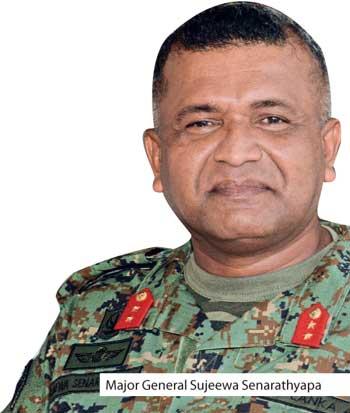 “We were informed that this factory would be needed to be converted into a Covid-19 care centre on the 5th of May. The process of vacating the premises by the apparel manufacturer, and the process of us converting this place into a healthcare facility had to happen simultaneously. Clearing the factory of all its earlier wares and occupants continued until about the 9th of May. It is at this point that we designed this complex as a hospital,” he said.
“We were informed that this factory would be needed to be converted into a Covid-19 care centre on the 5th of May. The process of vacating the premises by the apparel manufacturer, and the process of us converting this place into a healthcare facility had to happen simultaneously. Clearing the factory of all its earlier wares and occupants continued until about the 9th of May. It is at this point that we designed this complex as a hospital,” he said.
According to Major General Senarathyapa the requirement outlined by the Army Commander was to be able to accommodate a large number of patients. “As of now, we can accommodate 1,200 patients at this facility, comprised of three main wards, a high dependency unit, accommodation for clergy, family units and efforts are underway to install a fully functional Intensive Care Unit as well,” he said.
The theme “SenehasakaVijayagrahanaya” has been a instrumental to rally the troops round this cause.The military’s effort was to reinstate hope among the people, Major General Senarathyapa said. “With the things you constantly see in media, especially with the Indian experience of Covid-19, there was a cloud of uncertainty hovering around us. People have constant doubts and questions about this disease and as to what would happen to them. The vision of the Army Commander was to change this. We wanted to instill hope and positivity, and assure our people that they would be cared for. We wanted to assure them that they won’t be cast out or neglected,”
“This however is not a sole effort. If not for the contributions of the SevaVanitha unit of the Sri Lanka Army, certain areas would have been very challenging to achieve in such a short period of time. They volunteered to assist us, especially in securing donors and coordinating the requirements of every patient. Their attention to detail will ensure that every patient who comes through these doors would have a positive experience here,” the Major General opined.
On one corner of each ward is a separate area equipped with specialized medical equipment and oxygen units, dedicated for patients who are in need of special care
Brigadier Lal Wijayatunga, whose troops have made this challenging project possible, said that the Army’s approach to any emergency was unique. “Our objectives here are not based on short-term basis . As we provide 1,200 beds, with a round the clock health staff and management, it will alleviate the burden on the hospital capacity to a great extent. The design and concept is homegrown. We are not just looking at taking care of the patient, while they are ill. We also want to shift their attitude. The place is designed in a way that their positivity of mind will be encouraged, while they will also adjust to a hygienic lifestyle,” Brigadier Wijayatunga said.
“Waste-water disposal was a problem when we started this project. This complex already had a waste water treatment facility, but it was not suitable for us, as we have to be mindful that the water is used by Covid-19 patients. Therefore, we made improvisations in two areas, with the help of the Engineers, and we were able to find appropriate solutions to treat and purify the waste water,” Brigadier Wijayatunga explained.
With the support of the Engineer Service Regiment and the Medical Corps, the troops of the 14 Brigade comprised at least 200 personnel per shift, in the run-up to the opening of this facility. In addition to basic patient lodging requirements, these officers have together increased the complex’s water capacity to 100,000 litres, while the recently established Agriculture Directorate attended to the facility’s landscaping and gardening requirements.
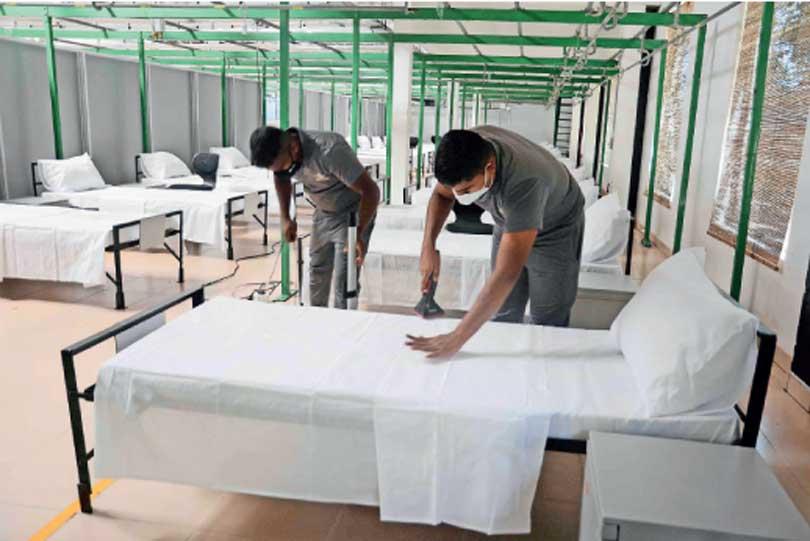
Bed linen are steamed and ironed at every ward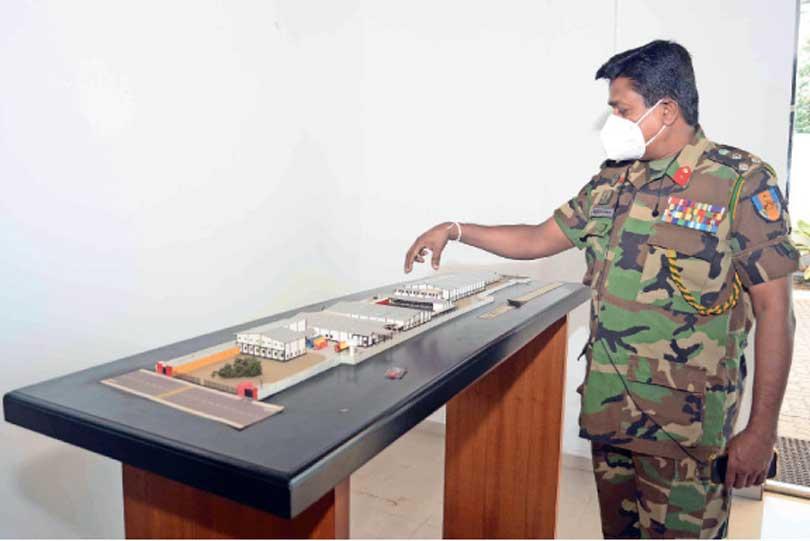
Brigadier Wijayatunga explains the design flow of the new facility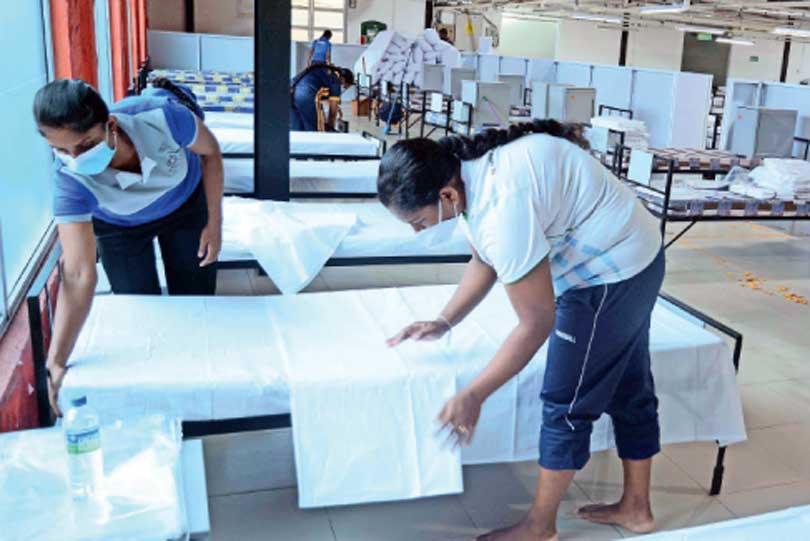
Female ward of the facility
Streamlined patient service, a key objective of design
As a patient is admitted to the hospital, registration is done at the central control room, where the patient’s personal details, medical history, information such as food preferences and allergies are recorded. Patients are also asked of their preferences to opt-in programmes and activities, designed to maintain positivity during their stay at a hospital. Once a patient is admitted, they receive a pack of toiletries, face masks and a flask and are then escorted to their designated bed. The beds which are numbered according to the ward allow the hospital’s nerve centre to monitor each and every patient remotely.
The hospital is divided into three large ward complexes, namely Nirodha, Nivarna and Sneha. Two of these wards are allocated for males and one for females. The Suwa Arana ward is a separate ward which is reserved
for clergy
The hospital is divided into three large ward complexes, namely Nirodha, Nivarna and Sneha. Two of these wards are allocated for males and one for females. The Suwa Arana ward is a separate ward which is reserved for clergy, while a bigger ward, the SuwaSahana ward has been designed as a family area. This ward is able to house several members of a single household in a closed-door room, comprising two to four beds.
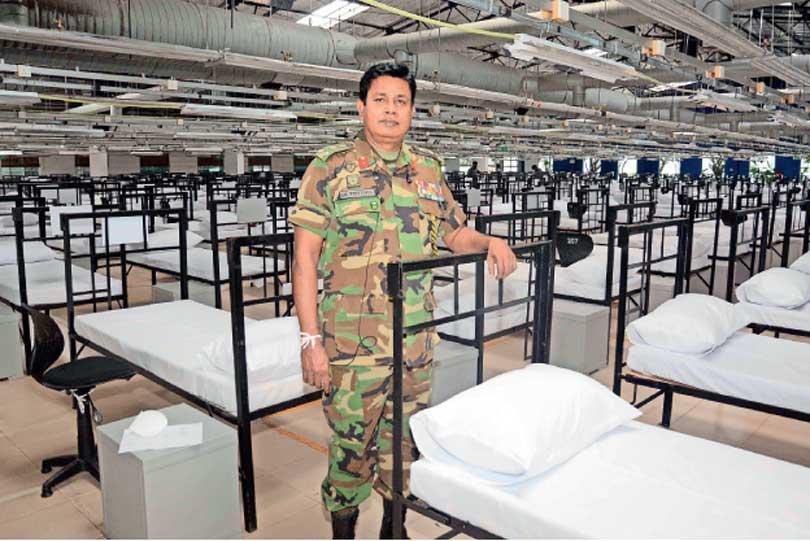
Brigadier Lal Wijayatunga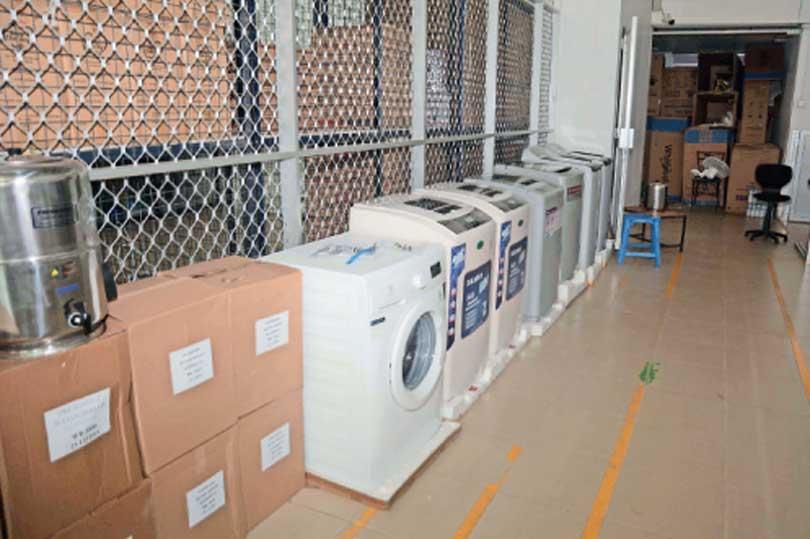
Donations received by the Seva Vanitha Unit of the Sri Lanka Army
All these wards have been sealed, so that no patient or maintenance staff can enter another area. All patients within a ward are monitored by healthcare staff dedicated to the hospital, through a separate glass wall, eliminating physical contact. The built-in counter system has been designed so that patients can call medical staff via phone for their needs, and medicine can be dispensed through counters which run along one side of the ward. For patients in need of physical check-ups, patients are required to enter a separate sealed chamber in Personal Protective Equipment (PPE) so that risk of contamination remains minimal. In a separate chamber of the complex, a new 12-bed Intensive Care Unit is being fitted to ensure that the hospital can serve patients in need of critical care.
The process of vacating the premises by the apparel manufacturer, and the process of us converting this place into a healthcare facility had to happen simultaneously. Clearing the factory of all its earlier wares and occupants continued until about the 9th of May
On one corner of each ward is a separate area equipped with specialised medical equipment and oxygen units, dedicated for patients who are in need of special care. Meals are provided in separate areas, external to the ward, where they are provided with pre-packed meals according to their dietary preferences. Each ward is also equipped with a separate area for washing, complete with newly installed toilettes and showers. The wards are also equipped with a centralised audio-system through which instructions to patients are given. When instructions are not in process, soothing music, religious or spiritual blessings are also offered through this system. Wards are also equipped with a refrigerator, water dispensers and boilers, charging outlets for electronic devices, television sets and washing machines, as well areas for clothes drying.The female ward, designed to ensure privacy, has an added layer of security as well, the officers informed us.
